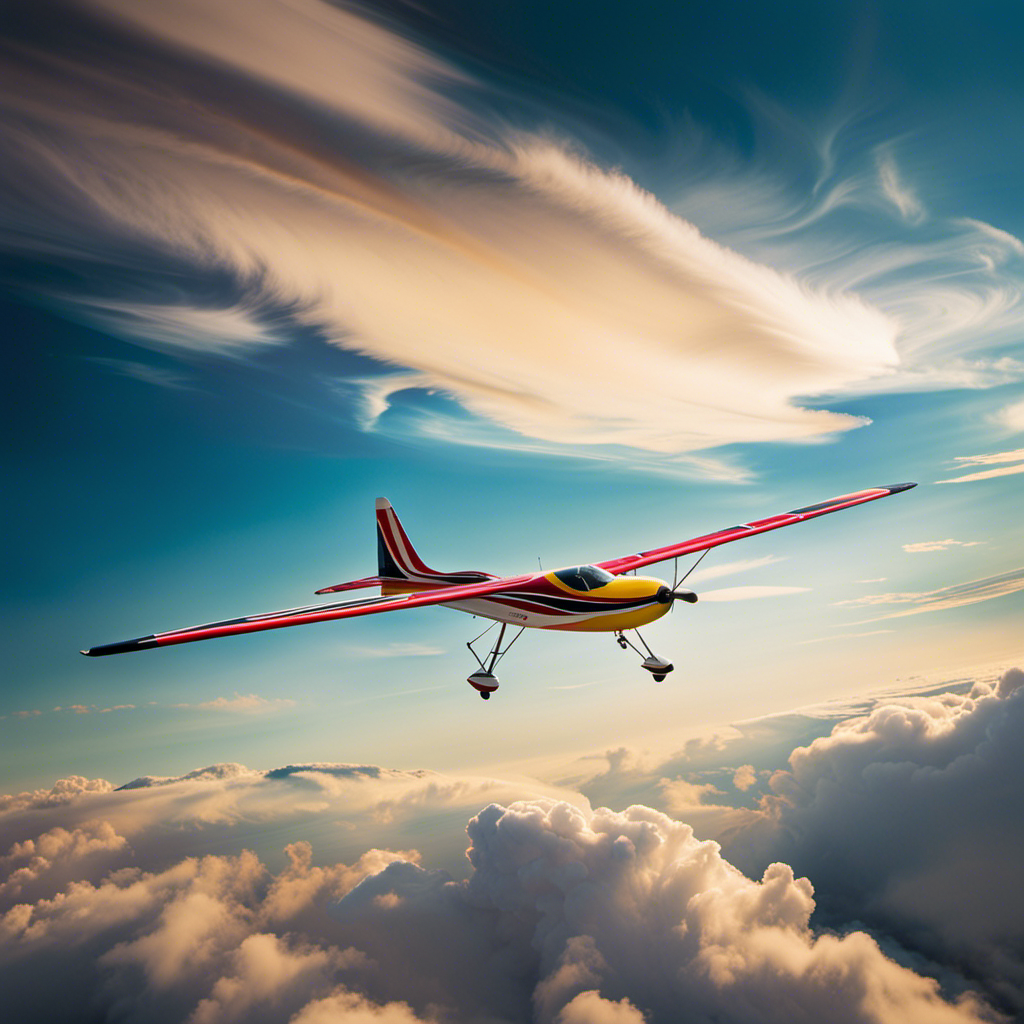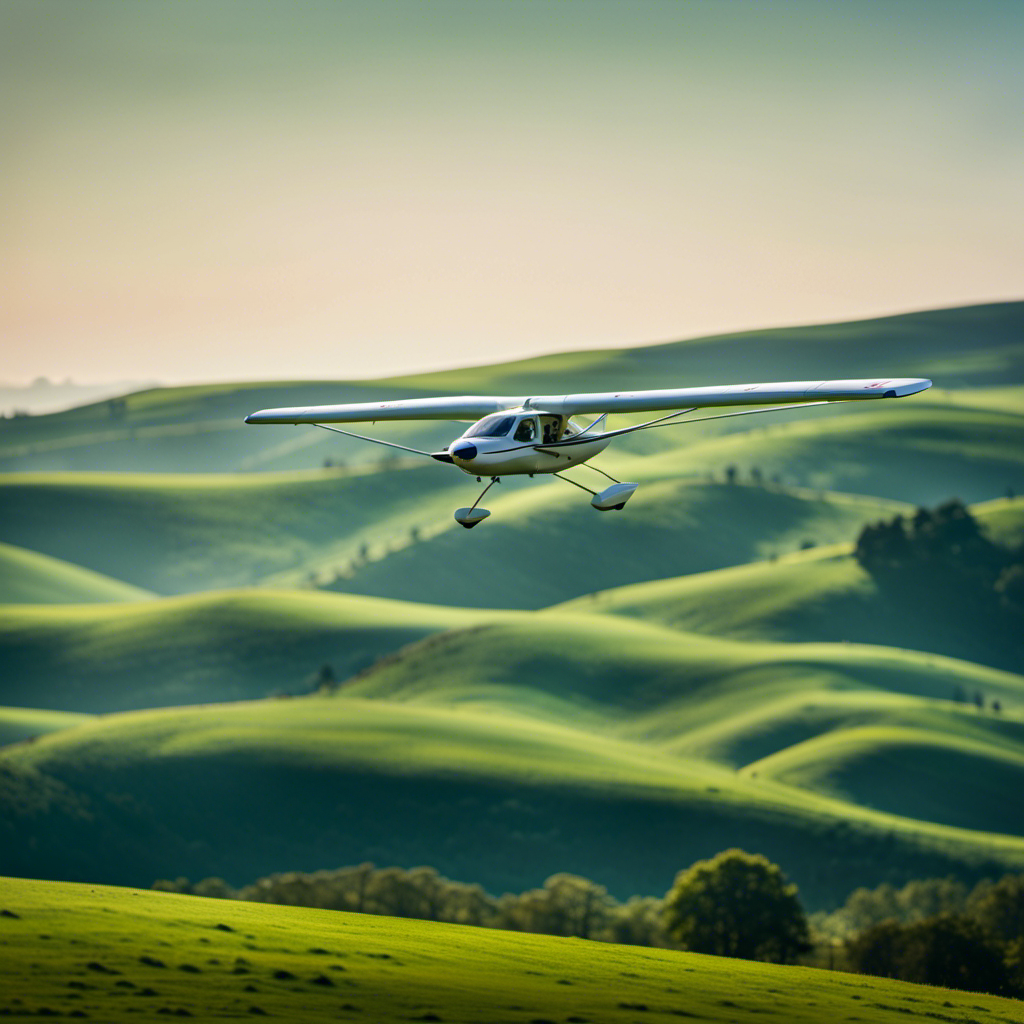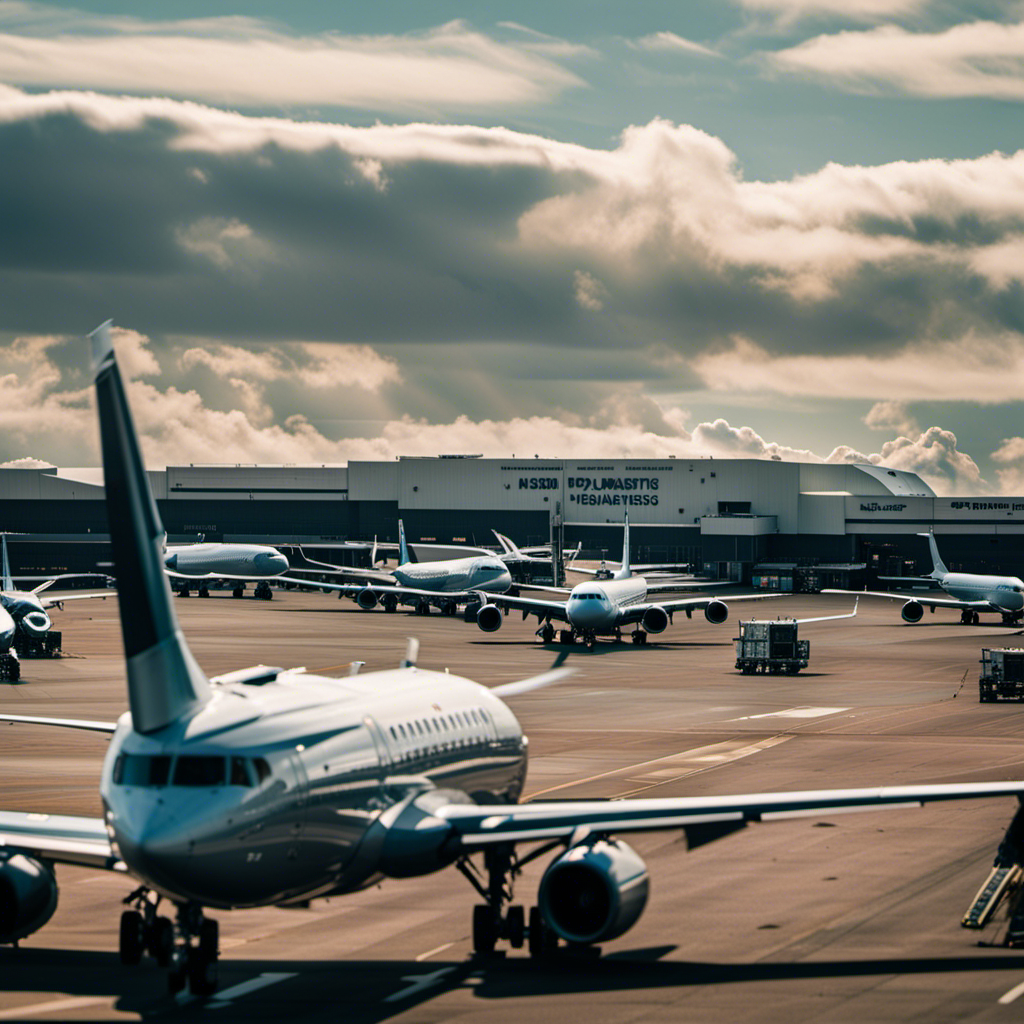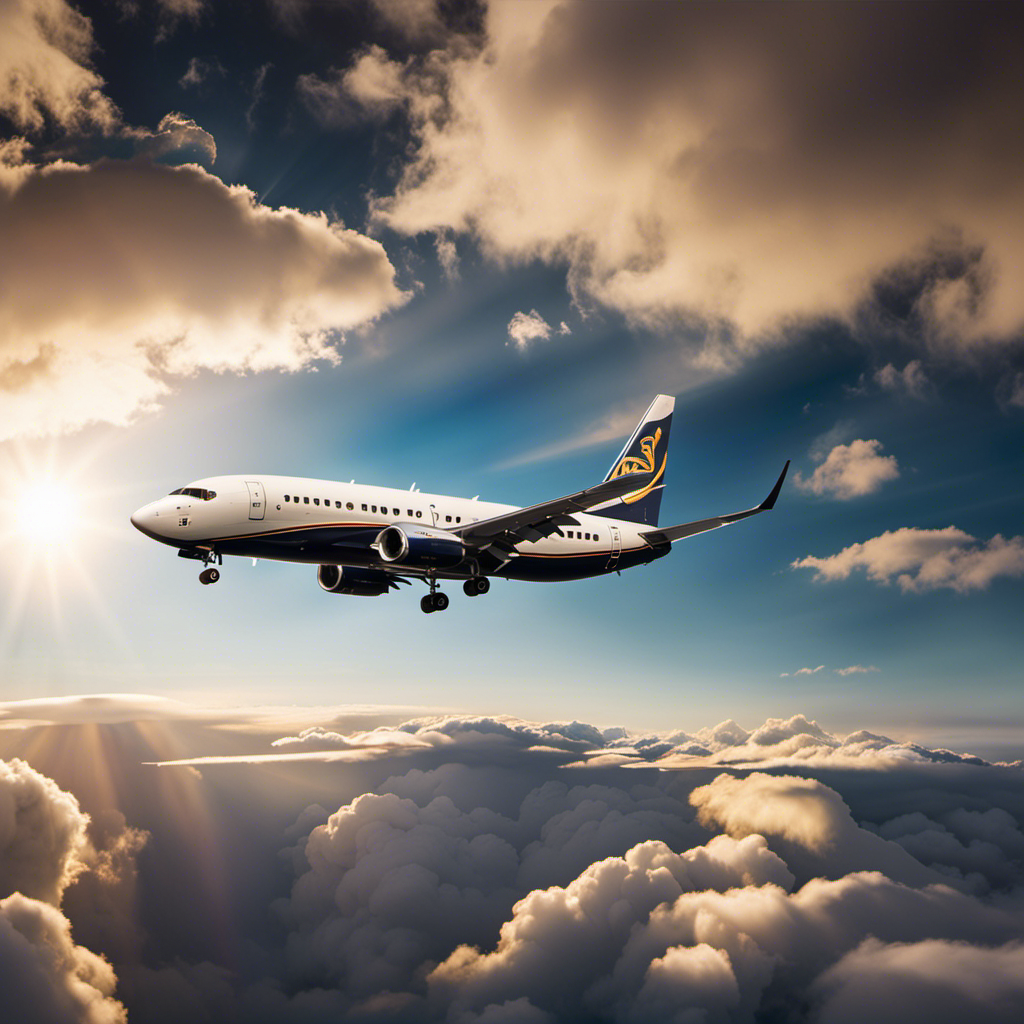As an experienced glider pilot, I can attest to the exhilarating sensation of riding on thermal updrafts.
Did you know that glider planes can stay aloft for hours without an engine?
In this article, I will share key takeaways from my glider plane lessons, including the basics of gliding, mastering turns and maneuvers, and understanding weather conditions.
Join me as we explore different gliding locations and delve into the thriving gliding community.
Get ready to discover the thrill of gliding and the endless possibilities it offers.
Key Takeaways
- Gliding is flying without an engine, using natural forces.
- Three key elements (pitch, roll, and yaw) control the glider.
- Proper speed control is crucial for a smooth turn.
- Understanding weather conditions is crucial for safe glider flights.
The Basics of Gliding
Now, let’s dive into the basics of gliding so you can understand how to control the glider plane.
Gliding is the art of flying without an engine, using only the forces of nature to stay aloft. To control a glider, you must master three key elements: pitch, roll, and yaw.
Pitch refers to the nose angle of the glider, which determines the speed and climb or descent rate.
Roll refers to the tilting motion around the longitudinal axis, allowing you to turn left or right.
Yaw is the side-to-side movement around the vertical axis, helping you maintain stability.
By manipulating these controls with precision and finesse, you can glide smoothly through the air.
Now that you understand the basics, let’s move on to preparing for your first flight, where you’ll learn the necessary safety procedures and techniques.
Preparing for Your First Flight
Before you take your first flight, make sure you’re adequately prepared. As an experienced glider pilot, I know the importance of being fully equipped and mentally ready.
Begin by familiarizing yourself with the aircraft’s controls, instruments, and emergency procedures.
Check the weather conditions, ensuring they are suitable for gliding.
Dress appropriately, wearing comfortable clothing and shoes that won’t hinder your movement.
Secure any loose items that could become a hazard during flight.
Lastly, mentally prepare yourself for the unique experience of flying without an engine. Visualize the motions and sensations you’ll encounter during takeoff, soaring, and landing.
Taking Off and Landing
Once you’re fully prepared, it’s time to take off and land your glider. As an experienced pilot, I’ve learned the importance of executing these maneuvers precisely.
When taking off, I carefully align the glider with the runway, ensuring the wind is favorable for a smooth departure. Applying full throttle, I maintain a steady acceleration until reaching the rotation speed. With a gentle pull on the controls, the glider gracefully lifts off the ground.
Landing requires a meticulous approach as well. I establish a stable descent path, adjusting the airspeed and descent rate accordingly. As the runway approaches, I flare the glider, reducing the descent rate and gently touching down on the main landing gear.
Mastering these fundamental techniques is vital before progressing to more advanced maneuvers, such as turns and aerobatics.
Mastering Turns and Maneuvers
When it comes to mastering turns and maneuvers, I’ve found that understanding and executing proper banking and turning techniques is crucial. These techniques involve smoothly and precisely tilting the wings of the aircraft to initiate a turn, while maintaining control and stability throughout the maneuver.
Additionally, as experienced pilots, we have the opportunity to explore more advanced maneuvers such as loops and rolls. These maneuvers require precise control inputs and a deep understanding of aerodynamics.
Banking and turning techniques
To improve your banking and turning techniques, remember to maintain a steady speed and smoothly apply pressure to the control stick. Here are four key takeaways to keep in mind:
-
Proper speed control: It’s crucial to maintain an appropriate airspeed throughout the maneuver. Flying too fast can result in a shallow turn, while flying too slow can lead to a stall.
-
Coordinate your controls: Use a coordinated combination of rudder and aileron inputs to maintain balance and prevent slipping or skidding. This will ensure a smooth and efficient turn.
-
Plan ahead: Anticipate your turn and plan the entry and exit points accordingly. This will help you maintain a consistent radius and prevent overshooting or undershooting your intended path.
-
Keep an eye on the horizon: Maintaining visual reference with the horizon is essential for maintaining a level bank and preventing unintentional roll angles.
Mastering these banking and turning techniques will set the foundation for performing loops and rolls, where precise control and coordination are paramount.
Performing loops and rolls
Performing loops and rolls requires precise control and coordination, which can be achieved by mastering banking and turning techniques. These advanced maneuvers test a pilot’s skills and push the boundaries of what a glider plane can do. To give you an idea of the complexity involved, here is a breakdown of the steps required for a loop maneuver:
| Step | Action | Result |
|---|---|---|
| Entry | Pull back on the stick | Nose points towards the sky |
| Pull | Increase back pressure | Glider climbs vertically |
| Over the top | Neutralize the controls | Glider in inverted flight |
| Exit | Push the stick forward | Glider dives down, completing loop |
Mastering these maneuvers requires practice and a deep understanding of aerodynamics. As experienced pilots, we strive to perfect these techniques and explore even more advanced maneuvers. Transitioning from loops and rolls, let’s now delve into the realm of advanced maneuvers for experienced pilots.
Advanced maneuvers for experienced pilots
Experienced pilots can achieve impressive feats in the air by mastering advanced maneuvers. These maneuvers require a combination of skill, precision, and an in-depth understanding of the aircraft’s capabilities.
Here are some key takeaways from my experience with advanced maneuvers:
-
Aerobatic Flight: Performing aerobatic maneuvers such as spins, hammerheads, and snap rolls requires precise control inputs and a thorough understanding of weight and balance.
-
Precision Landings: Landing a plane with pinpoint accuracy is a testament to a pilot’s skill. Advanced pilots learn techniques like the side slip and flare to achieve smooth and controlled landings.
-
Emergency Maneuvers: Advanced pilots are trained to handle unexpected situations like stalls, engine failures, and loss of control. These maneuvers require quick thinking and decisive actions to ensure the safety of the aircraft.
-
Formation Flying: Flying in close proximity to other aircraft requires exceptional situational awareness and precise control. Advanced pilots practice formation flying to enhance their skills and perform breathtaking aerial displays.
Mastering these advanced maneuvers is just one aspect of becoming a skilled pilot. Understanding weather conditions is another crucial factor in ensuring safe and successful flights. By analyzing weather patterns and making informed decisions, pilots can navigate the skies with confidence.
Understanding Weather Conditions
Understanding weather conditions is crucial when flying a glider plane. You’ll need to know how the wind, temperature, and air pressure can affect your flight.
As an experienced pilot, I have learned to pay close attention to meteorological reports and forecasts before taking off. Wind direction and speed determine the best runway for launching and landing, while temperature affects the air density and the performance of the glider. Air pressure variations indicate the presence of thermals, which are crucial for gaining altitude and extending your flight time.
By understanding these weather conditions, I am able to plan my flights more effectively and make informed decisions during the journey.
Now, let’s delve into improving your gliding skills and techniques to enhance your overall performance in the air.
Improving Your Gliding Skills
To improve your gliding skills, it’s important to practice different maneuvers and techniques in order to become a more proficient pilot.
One technique that I find particularly useful is the spiral dive. This maneuver involves entering a steep, coordinated turn while maintaining a constant airspeed. Not only does it help you lose altitude quickly, but it also helps you gain a better understanding of how your glider responds to different control inputs.
Another important skill to develop is the ability to identify and utilize thermals. Thermals are rising columns of warm air that can provide lift and allow you to stay airborne for longer periods of time. By learning how to find and ride thermals, you can extend your flights and explore different gliding locations seamlessly.
Exploring Different Gliding Locations
After honing my gliding skills and becoming more confident in the air, I was eager to explore different gliding locations. Each location offers unique challenges and opportunities to refine my techniques.
I have had the privilege of soaring over vast plains, picturesque mountains, and serene lakes, each providing its own breathtaking views and exhilarating experiences. The diverse landscapes have taught me to adapt and adjust my flying style accordingly, whether it’s navigating through turbulent winds or finding elusive thermals.
Exploring different gliding locations has not only expanded my knowledge and skills but has also allowed me to appreciate the beauty of nature from a whole new perspective. As I continue to discover more awe-inspiring places to glide, I am constantly reminded of the incredible adventures that await me and the limitless possibilities that come with being a part of the gliding community.
Joining the Gliding Community
As an experienced glider pilot, I can attest to the numerous benefits of joining a gliding club.
Not only does it provide a supportive community of like-minded individuals who share a passion for gliding, but it also offers valuable networking opportunities with other glider pilots.
Through these connections, I have been able to participate in gliding competitions and events. These experiences have not only enhanced my skills but also allowed me to immerse myself in the exhilarating world of gliding.
Benefits of joining a gliding club
If you join a gliding club, you’ll have access to a supportive community of fellow glider pilots. This is one of the key benefits of joining a gliding club.
Being part of a community that shares your passion for gliding can provide invaluable support and guidance as you learn and improve your skills.
In a gliding club, you’ll have the opportunity to learn from experienced pilots, participate in group flights, and engage in discussions about techniques and safety measures.
This sense of camaraderie is not only enjoyable, but it also helps to accelerate your progress as a glider pilot.
Networking with other glider pilots allows you to build relationships, exchange knowledge, and stay updated on the latest advancements in gliding technology and techniques.
Networking with other glider pilots
Joining a gliding club allows you to connect and network with other experienced pilots who can offer mentorship and support. Networking with other glider pilots is a valuable opportunity to learn from their experiences and gain insights into the world of gliding. Here are four key benefits of networking within a gliding club:
-
Knowledge sharing: Connecting with other pilots allows you to exchange tips, techniques, and information about gliding. This collaborative environment fosters continuous learning and improvement.
-
Mentorship: Seasoned glider pilots can provide guidance and support as you navigate your own gliding journey. Their expertise and advice can help you develop your skills and make informed decisions.
-
Camaraderie: Building relationships with fellow glider pilots creates a sense of community and camaraderie. Sharing the passion for flying with like-minded individuals can enhance your overall gliding experience.
-
Opportunities for collaboration: Networking can open doors to collaborative projects, such as participating in group flights, organizing events, or even working on research endeavors together.
Participating in gliding competitions and events
Participating in gliding competitions and events offers an opportunity to test your skills and compete against other experienced pilots in a challenging and exciting environment. It is an excellent way to push your limits and enhance your flying abilities.
These competitions demand precision, strategy, and a deep understanding of glider dynamics. The key to success lies in effectively utilizing thermals, optimizing speed, and executing precise maneuvers. It is essential to analyze weather conditions, identify potential thermals, and exploit them to gain altitude and cover long distances.
Moreover, engaging in these events allows you to learn from other skilled pilots, exchange experiences, and expand your network within the gliding community. By immersing yourself in the competitive spirit, you can further refine your techniques and broaden your knowledge.
Transitioning into glider plane maintenance and care, it is crucial to ensure the aircraft’s optimal condition to perform at its peak during these competitions and events.
Glider Plane Maintenance and Care
As a seasoned glider pilot, I understand the importance of regular inspections and upkeep when it comes to maintaining a glider plane. Regular inspections help identify any potential issues or wear and tear that may affect the aircraft’s performance.
Additionally, proper storage and transport considerations are crucial to ensure the glider plane’s longevity and prevent damage during transit.
Lastly, troubleshooting common issues is an essential skill for any glider pilot, as it allows for quick and efficient resolutions to ensure a safe and enjoyable flying experience.
Regular inspections and upkeep
Regular inspections and upkeep are essential for maintaining the safety and performance of glider planes. As a seasoned glider pilot, I understand the importance of meticulous care to ensure a smooth and safe flight.
Here are a few key considerations:
-
Structural integrity: Regularly inspect the airframe for any signs of damage or wear that could compromise the plane’s structure.
-
Control surfaces: Check the rudder, elevator, and ailerons for proper functionality and ensure that they move freely without any binding or excessive play.
-
Wire tension: Regularly check the tension of the control wires to ensure precise and responsive control inputs.
-
Instrument calibration: Verify the accuracy of the altimeter, airspeed indicator, and variometer to ensure accurate readings during flight.
By adhering to these maintenance practices, you can ensure the safety and optimal performance of your glider plane.
Now, let’s delve into the crucial considerations for storing and transporting your glider.
Storage and transport considerations
Storing and transporting a glider requires careful planning to ensure its safety and prevent any damage. As an experienced glider pilot, I understand the importance of proper storage and transportation procedures. To aid in this process, I have created a table below outlining key considerations for both storage and transport.
| Storage Considerations | Transport Considerations |
|---|---|
| Hangar or Trailer | Secure Tie-Downs |
| Climate Control | Wing and Tail Protection |
| Wing Racking | Proper Weight Distribution |
When storing a glider, it is essential to have a suitable hangar or trailer that provides protection from the elements. Climate control helps maintain optimal conditions and prevents damage to sensitive components. Additionally, wing racking ensures the wings are properly supported to prevent warping or stress.
For transport, secure tie-downs are crucial to prevent shifting or movement during transit. Protecting the wings and tail with covers or padding is also necessary to avoid any potential damage. Lastly, proper weight distribution within the trailer or on the roof rack helps maintain stability and balance during transportation.
Understanding these storage and transport considerations is vital to ensuring the safety and longevity of your glider. By following these guidelines, you can minimize the risk of damage and enjoy many successful flights. Now, let’s move on to troubleshooting common issues that may arise during glider operations.
Troubleshooting common issues
After discussing storage and transport considerations, I now move on to troubleshooting common issues that can arise during glider plane lessons.
As an experienced pilot, I have encountered various problems in the air and have learned how to address them swiftly and effectively. From sudden loss of altitude to control malfunctions, these issues require quick thinking and precise actions.
One common problem is the loss of lift due to improper positioning within the thermal. Adjusting the glider’s position and taking advantage of wind currents can help regain lift and stay airborne.
Another issue is encountering turbulence, which can disrupt the smooth glide. Anticipating turbulence and making small adjustments to the flight path can help maintain stability.
By addressing these common issues, pilots can ensure a safe and enjoyable flight experience.
Now, let’s delve into the thrill of gliding and the exhilaration it brings.
The Thrill of Gliding
During the glider plane lessons, you’ll experience the thrill of gliding through the air without an engine. As a glider pilot, I can tell you that there is nothing quite like the feeling of soaring through the sky, relying solely on the natural forces of the wind and thermals.
Gliding allows you to fully immerse yourself in the pure joy of flight, as you become one with the elements. The absence of an engine brings a sense of freedom and tranquility, as you gracefully navigate the air currents.
It takes skill and precision to harness the power of thermals and ride them, maximizing your flight time and distance. Gliding is a unique and exhilarating experience that every aviation enthusiast should try at least once.
Frequently Asked Questions
What is the average cost of a glider plane and the associated equipment?
The average cost of a glider plane and its associated equipment can vary depending on factors such as the model, features, and condition. It is best to consult with a glider plane dealer or experienced pilot for an accurate estimate.
Are there any age restrictions or physical requirements for glider pilots?
There are no age restrictions for glider pilots, but physical requirements include good eyesight, coordination, and the ability to handle the aircraft’s controls. Flying a glider is like dancing on air, exhilarating and freeing.
How long does it take to become a proficient glider pilot?
It takes several months of consistent training and practice to become a proficient glider pilot. Mastery of flight controls, understanding aerodynamics, and developing situational awareness are essential skills that require dedication and experience.
What safety precautions should be taken while flying a glider?
When flying a glider, it’s crucial to prioritize safety. Always conduct a thorough pre-flight inspection, wear appropriate safety gear, and be mindful of weather conditions. Remember, "better safe than sorry."
Are there any specific regulations or licenses required to fly a glider plane?
Yes, there are specific regulations and licenses required to fly a glider plane. Pilots must obtain a glider pilot license and comply with aviation regulations set by the governing aviation authority.
Conclusion
In conclusion, gliding is not just a sport, but a true passion that requires dedication, practice, and a deep understanding of the principles of flight.
Whether you are a beginner or an experienced pilot, mastering the art of gliding will bring you unparalleled joy and a sense of freedom like no other.
So, strap yourself in, keep your eyes on the horizon, and let the thermal currents guide you.
Embrace the thrill of gliding and soar through the skies with confidence and grace.
With a heart that soars as high as the skies, Aria, affectionately known as “Skylark,” is the driving force behind Soaring Skyways. Her journey into the gliding world began as a young dreamer gazing up at the soaring birds, yearning to experience the weightlessness and freedom they embodied. With years of experience both in the cockpit and behind the scenes, Aria’s commitment to the gliding community is unwavering.










